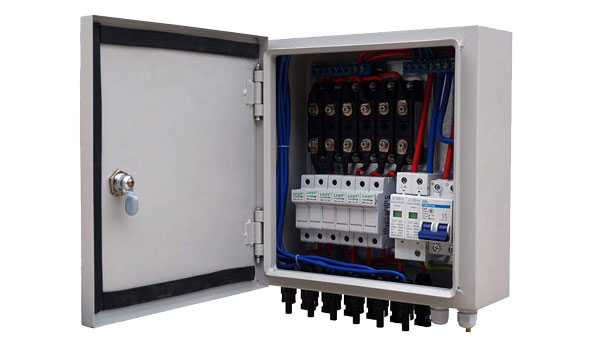
So you’ve misdrilled a few holes and gotten your solar panels up, now you’re trying to figure out what to do with all those damn wires. First you try twist-tying them together, but as the first stiff breeze unseats your work, you think to yourself, “There must be a better way!”
No? Just me? You actually do your research before taking on projects? Must be nice … Anyhow, this week we are here to talk combiner boxes. Are they absolutely necessary for solar energy? Maybe not. But if you’re serious about energizing your house with the sun, a combiner box can be a great idea. Read on for more information on this relatively cheap addition to your energy setup.
Fundamentals
As discussed in our solar-power primer, a combiner box’s main utility comes from its ability to link multiple panels together. Each string from each solar panel is attached to a fuse terminal, whose outputs are, in turn, combined into a single cable that runs to the inverter box. As mentioned, they are not fully necessary for small systems (those under three strings as a general rule), but they will yield benefits to systems of any size.
Benefits
For all systems, the box serves as a consolidation point for cables. This makes for a simplified point of maintenance, not to mention installation and emergency disconnection. They also act as a relatively cheap surge protector for your system, preventing excess voltage and current from hitting your inverter. Of course, charge controllers, which we’ll cover later, provide the real defense against this, but combiner boxes can make a secondary contribution as well.
As they are hardy components, combiner boxes generally do not wear out like other, more fragile parts of the system. Simply check for loose connections every now and then. The larger the system, the more the units (when properly placed a short distance between the panels and the inverter) can also boost system efficiency, by lessening connection points and reducing voltage drop.
What to Look For
As mentioned, combiner boxes are one of the cheaper components in the system, so you may as well shell out a few extra bucks for a good ones–especially considering it’s the first thing connected to your solar panels. The most important thing to ensure is that it has enough fuse terminals to accommodate your panel strings. Aside from this, make sure the box is UL471 certified–risking your system on a lesser unit just isn’t worth it.
While you can wire your own combiner box, I wouldn’t recommend it for the amateur. There are enough cheap, yet reliable systems on the market today to make doing it yourself not just unnecessary, but also possibly more expensive when all the component parts are added up.
Do your homework on a few options for combiners this week, as next week we’ll be getting into charge controllers, the TRUE surge protectors and saviors of your system.
A humble homesteader based in an undisclosed location, Lars Drecker splits his time between tending his little slice of self-sustaining heaven, and bothering his neighbors to do his work for him. This is mainly the fault of a debilitating predilection for fishing, hunting, camping and all other things outdoors. When not engaged in any of the above activities, you can normally find him broken down on the side of the road, in some piece of junk he just “fixed-up.”

Jesse Mathewson says
Not many people think if this! Even with small installs it is a great idea to have. Solid!